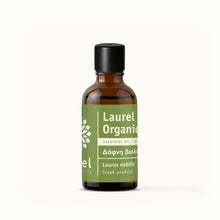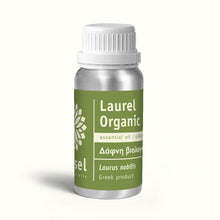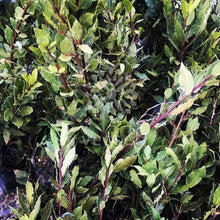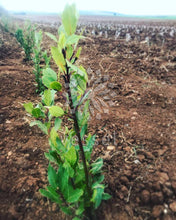Greek Laurel Organic Essential Oil
Regular price
€11.00
€11.00
Sale
If you are interested in buying larger size quantities we would love to receive your email at info@vessel.gr
Greek Laurel Essential Oil
Batch: E1001849



BAY LAUREL
Other common names: laurel, sweet bay, bay leaf, Grecian laurel, bay
Bay laurel must not be confused with West Indian Bay Pimentaracemosa.
Botanical name: Laurus nobilis
Botanical family: Lauraceae
Method of extraction: Steam distillation
Plant part used to extract the oil: freshly picked leaves
Cultivation method: organic
Area of origin: our oil is distilled from laurel cultivations in Chalkidiki, in the northern part of Greece.
The Bay Laurel was used from ancient years in Greece. It was a symbol of highest status. Also they used the branche as prize to Pythian games to honor God Apollo because it is one of his symbols.
The Laurel belongs to a plant familiy Lauraceae, sp. Laurus nobilis. Our Laurel essential oil comes from cultivations of Chalkidiki at the northern part of Greece.
As all the other essential oils, the proper conditions enhance the transformation of essential oil’s molecules giving special odor and organoleptic properties that differentiate it from the other countries’ laurel essential oils.
There are not few people who admit that this laurel essential oil is the best that they have ever smelled.
You want to smell our Laurel too?
Historical notes:
According to Greek mythology, the nymph Daphne was transformed into a bay laurel tree by her father (the river god Ladon) to save her from the unwanted affections of the god Apollo. This is howbay tree became a symbol of Apollo, god of music, poetry, art, oracles, truth, archery, plague, medicine, healing, sun, light and knowledge.
It is believed that Pythia, the priestess of Apollo, chewed leaves from a sacred bay laureltree growing inside the temple in Delphi. As high doses of bay laurel leaves can have a narcotic effect so they would have been used to induce trance from which the oracular prophecies could be offered.
The Greeks considered bay laurel as a medicine that could protect against diseases, especially against the plague. It was often devoted to Asclepios, the son of Apollo and the god of medicine.Greek physician, Hippocrates of Kos (c. 460 – c. 370 BC), known as the "Father of Medicine", used all parts of the plant as a remedy for a variety of ailments, both internally and externally.
Today, bay laurel is perhaps best known for the laurel wreaths of the ancient Greece. They were a symbol of high status as well as a sign of academic distinction (‘poet laureate’ and ‘baccalaureate’ derive from that) and victory. They were awarded as a prize at the Pythian Games.
Biochemical group: Oxide
Main chemical compounds: 1,8-cineole, sabinene, terpinyl acetate, α-pinene,β-pinene, linalool, terpinen-4-ol,others
Colour: clear
Consistency: thin
Aroma strength: strong
Perfumery note: top/middle
Aroma: spicy, sweet, fresh,peppery, with warm and gentle camphoraceous notes, refreshing and invigorating, with a hint of clove
Traditional aromatherapy uses:
- Traditionally in aromatherapy treatments bay laurel is associated with the following therapeutic properties: analgesic, anti-bacterial, anti-inflammatory, anti-microbial, anti-oxidant, antiseptic, anti-spasmodic, anti-viral, carminative, cholagogue, decongestant, digestive tonic, diuretic, emmenagogue, febrifuge, hypotensive, immune support, lymphatic support, stomachic, tonic, warming
- Qualified aromatherapists may use bay laurel essential oil for common complaints such as:
- respiratory conditions: employed in inhalations for bronchitis and infectious diseases including fever
- lymphatic system: immune support, swollen, congested lymph nodes
- digestive issues: flatulence, indigestion, loss of appetite, tonic to the liver and gallbladder
- musculoskeletal system: pains and sprains, arthritic and rheumatic conditions
- hair care: scalp tonic, flaky scalp, hair tonic, alopecia, oily hair
- others
- How we use it:
Please, also see our How to Use Essential Oils Safely page for more information.
- For hair care - add together with our Organic Lavender essential oil to an unscented shampoo
- For respiratory conditions –vapourise a drop of Bay Laurel with some Lemon essential oil to ease congestion associated with colds and flu
- For a muscular aches and pains massage oil – we dilute our bay laurel with some Lavender and/or Rosemary and/or Black Pine essential oil in a fixed oil (carrier oil) and massage the affected areas
- To support digestion or ease flatulence – dilute together with a drop of Mandarin and/or Sweet Orange oil in a fixed oil (carrier oil) and massage the abdomen.
- For a quick ‘pick me up’ sniff one drop of our gorgeous Bay Laurel from a tissue. Larger quantities are should be avoided (see safety consideration information below).
Safety considerations:
Tisserand and Young indicate that Bay Laurel is not suitable for hypersensitivem diseased or damaged skin. There is generally a low risk of sensitization but the oil might be potentially carcinogenic due to the presence of methyleugenol.
Oils high in 1,8-cineole may cause CNS and breathing problems in young children and should not be used on or near the faces of children under the age of 10. This oil should not be used on the skin of children under 2 years of age.
They recommend a dermal maximum of 0.5%, but it is worth mentioning that EU recommendation is different at 0.005% (This is a rough equivalent of one drop in a litre of medium!)
Reading Tisserand and Young's full profile is recommended. [Robert Tisserand and Rodney Young, Essential Oil Safety (Second Edition.United Kingdom: Churchill Livingstone Elsevier, 2014), 323.]
Please, also see our How to Use Essential Oils Safely page for more information.
Research and studies:
- Analgesic and anti-inflammatory activity of the leaf essential oil of Laurusnobilis Linn.
https://www.ncbi.nlm.nih.gov/pubmed/12916069
- Antioxidant and antiproliferative activity of Laurusnobilis L. (Lauraceae) leaves and seeds essential oils against K562 human chronic myelogenous leukaemia cells.
https://www.ncbi.nlm.nih.gov/pubmed/22017546











